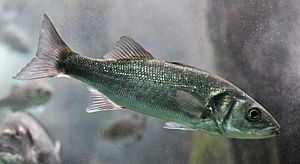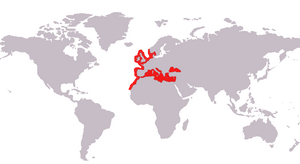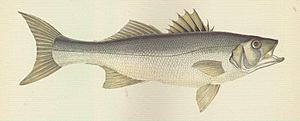European bass facts for kids
Quick facts for kids European bass |
|
|---|---|
 |
|
| Conservation status | |
| Scientific classification | |
 |
|
| Distribution of European bass | |
| Synonyms | |
|
click to expand
Perca labrax Linnaeus, 1758
Labrax labrax (Linnaeus, 1758) Morone labrax (Linnaeus, 1758) Roccus labrax (Linnaeus, 1758) Sciaena labrax (Linnaeus, 1758) Sciaena diacantha Bloch, 1792 Labrax diacanthus (Bloch, 1792) Perca diacantha (Bloch, 1792) Centropomus lupus Lacepède, 1802 Dicentrarchus lupus (Lacepède, 1802) Labrax lupus (Lacepède, 1802) Centropomus mullus Lacepède, 1802 Perca elongata É. Geoffroy Saint-Hilaire, 1817 Dicentrarchus elongatus (É. Geoffroy Saint-Hilaire, 1817) Labrax elongatus (É. Geoffroy Saint-Hilaire, 1817) Perca sinuosa É. Geoffroy Saint-Hilaire, 1817 Labrax vulgaris Guérin-Méneville, 1829-38 Labrax linnei Malm, 1877 |
The European bass (Dicentrarchus labrax) is a cool fish that lives mostly in the ocean. You can find it near the coasts of western and southern Europe. It also swims along the northern coasts of Africa. During summer, it likes to hang out in shallow waters and near river mouths.
This fish is one of only six species in its family, called Moronidae. These fish are known as temperate basses. People catch and farm European bass for food. It's a very important fish for farming in the Mediterranean Sea. In countries like Ireland and the United Kingdom, when you order "sea bass" at a restaurant, you're usually eating this fish. In North America, it's often called branzino, which is its Italian name.
European bass grow slowly and take several years to become fully grown. An adult European seabass usually weighs about 5 kilograms (11 pounds). They can grow up to 1 meter (3 feet 3 inches) long and weigh 12 kilograms (26 pounds). However, most European bass are about half that size, around 0.5 meters (1 foot 8 inches) long. These fish are usually silvery grey. Sometimes, their backs can look a bit dark bluish.
Young European bass swim together in groups. They eat small invertebrates. Older bass are more independent and prefer to eat other fish. In summer, they often stay near riverbanks, lagoons, and estuaries. When winter comes, they move further out into the sea. European sea bass enjoy eating prawns, crabs, and small fish. Even though many people like to catch them for sport, they are listed as Least Concern by the International Union for the Conservation of Nature. This means they are widespread, and there are no big threats to them right now.
Contents
About Its Name
The European bass was first described in 1758. A Swedish zoologist named Carl Linnaeus gave it the name Perca labrax. This was in his famous book Systema Naturae. Over the next 150 years, it got many different scientific names. But in 1987, Dicentrarchus labrax became the official accepted name.
The first part of its scientific name, Dicentrarchus, comes from Greek words. "Di" means two, "kentron" means sting, and "archos" means anus. This refers to the two spines it has near its anal fin. The European bass has many common names around the world. In the British Isles, people call it "European bass," "sea bass," or just "bass."
There are two groups of wild European bass that are genetically different. One group lives in the northeast Atlantic Ocean. The other group lives in the western Mediterranean Sea. These two groups are separated by a small area near the Spanish city of Almería. Scientists are not sure why they stay separated. Even though young bass can float for up to 3 months, they don't seem to mix much. Adult bass can also travel hundreds of miles.
Where They Live and Their Home
European bass live in many different places. These include estuaries (where rivers meet the sea), lagoons, coastal waters, and rivers. You can find them in a large part of the eastern Atlantic Ocean. Their range stretches from southern Norway all the way to Senegal. They also live in the entire Mediterranean Sea and the southern Black Sea. However, you won't find them in the Baltic Sea. They are a migratory species. This means they move closer to shore and further north during the summer months.
Diet and Behavior
The European bass usually hunts at night. It eats small fish, worms called polychaetes, cephalopods (like squid), and crustaceans (like crabs). They lay their eggs, which is called spawning, from March to June. This mostly happens in waters close to the shore.
When they are very young, called fry, they float in the open water. As they grow bigger, they move into estuaries. They usually stay there for one or two years before moving to other areas.
Fishing and Farming
Catching Wild Bass
People catch a moderate number of wild European bass each year. Between 2000 and 2009, catches were between 8,500 and 11,900 tonnes. Most of these fish were caught in the Atlantic Ocean. France usually catches the most. In the Mediterranean, Egypt now catches more than Italy used to.
Wild European bass have been under more pressure from commercial fishing. In the United Kingdom, people who fish for fun have started a conservation effort to protect them. The Republic of Ireland has strong rules about catching bass. It is against the law to fish for them commercially. There are also rules for people who fish for fun. For example, there's a time of year when you can't fish for them (May 15 to June 15). Also, the fish must be at least 400 millimeters (about 16 inches) long. You can only catch two fish per day. Scientists have noticed that more bass are being caught. The total number of bass in the sea has been going down since 2005.
Farming Bass
European bass was one of the first fish to be farmed in Europe. For a long time, they were raised in coastal lagoons and special ponds. Then, in the late 1960s, new ways to farm them in large numbers were developed. Today, it is the most important fish farmed in the Mediterranean Sea.
The main countries that farm European bass are Greece, Turkey, Italy, Spain, Croatia, and Egypt. In 2010, over 120,000 tonnes of European bass were farmed. This fish is known by many names in different languages. For example, it's called lavraki in Greek, levrek in Turkish, and lubina in Spanish.
See also
 In Spanish: Lubina para niños
In Spanish: Lubina para niños




